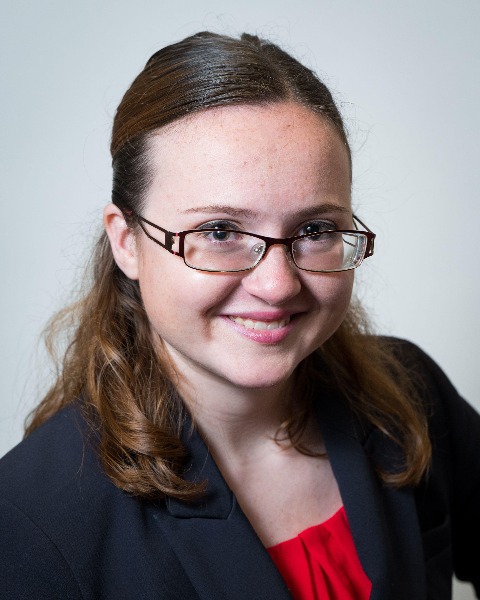Biomaterials
Computational Study of Cell Mobility and Morphology in Degrading Biological Scaffolding
(B-67) Computational Study of Cell Mobility and Morphology in Degrading Biological Scaffolding

Lauren V. Kadlec (she/her/hers)
Undergraduate Student
Valparaiso University
Maple Grove, Minnesota, United States- BL
Bethany Luke, PhD
Assistant Professor
Valparaiso University, United States
Presenting Author(s)
Last Author(s)
Ligament injuries are some of the most common injuries to the musculoskeletal system1. These injuries can be devastating, as ligaments often heal improperly leaving them susceptible to recurrent injuries2. Replacing damaged ligament tissue fibers with synthetic, parallel-aligned tissue scaffolds is a potential solution to this problem. Inserting a tissue scaffold delivers cells and stimulates them to move more favorably, leading them to better repair the ligament. As the cells generate new fibers, the synthetic scaffolding degrades away, leaving the patient with a natural ligament once healed3. Resorbable scaffolds have been studied extensively and these studies have used cell velocity and aspect ratio (AR) as predictors of successful tissue placement3, 4. However, fiber degradation’s effects on cell velocity and AR is rarely studied. A computational model was adapted to study how degradation of the matrix affects cell velocity and AR. If degradation is shown to have an effect in the model, that could indicate a similar effect on a physical scaffold of similar parameters.
Materials and Methods::
The biological scaffolding model was adapted from an existing model.5 To determine the effect of degradation, simulations were run for a length of 4000 points. 4000 simulation points were chosen based on the results of 6 control simulations. The first 2000 points had no degradation, allowing the cell to reach steady state and the average velocity and AR was recorded. Then, the matrix was degraded by a percentage (shown in figures 1-2) using a Metropolis Monte Carlo approach and the cell was simulated for another 2000 points and the average velocity and AR were recorded again. The average ARs and velocities from the last 2000 points were divided by their respective averages from the first 2000 points to create a ratio (R), according to the equation:
Ri = Aafter, i ⁄ Abefore, i
Where Aafter is the average value of i after degradation occurs, Abefore is the average value of i before degradation occurs, and i is either velocity or AR.
These ratios from before and after degradation were compared using curve fitting. The ratios of ARs were related to the percentage degraded using a linear regression, while the ratios of velocities were related to the percentage degraded using a logistic regression. The logistic regression has the following equation:
Rvel = 1 ⁄ (1 + exp(k(D - b)))
Where Rvel is the ratio of velocities before and after degradation, D is the percent degraded, and k and b are constants determined through curve fitting.
Results, Conclusions, and Discussions::
Results and Discussion: The degradation simulation results fell into three general categories: unstopped, stopped, and pseudostopped. Of the 264 simulations, 95 stopped, 36 pseudostopped, and 133 were unstopped. Over 94% of simulations with degradation below 70% were unstopped; the cell continued to move throughout the entire simulation. Above 70% degradation, some cells would stop. In those cases, the cell would not have any undegraded fibers in its vicinity to attach to, so it would stop moving. Cells that pseudostopped would only have a select few undegraded fibers in their vicinity, so they would go between several positions repeatedly.
Figure 1 shows the ratios of the average velocity before and after degradation. A logistic curve fit was used. The curve fit had a strong correlation with an r value of 0.911. The b value of 0.829 indicates that the average velocity ratio is reduced by half when the collagen matrix is degraded by 82.9%. The k value of 25.98 indicates a relatively steep drop between velocity ratios of 1 and 0 around 82.9% degradation.
Figure 2 shows the ratios of the average AR before and after degradation. A linear regression showed no statistically significant correlation between a cell’s aspect ratio and percent degradation of the matrix (p=0.11).
Conclusion: At higher degradations, our model showed cells stopping or pseudo-stopping more frequently. No significant correlation was found between aspect ratio and degradation (p=0.11), but velocity decreased as more of the matrix degraded following a logistic curve (r=0.911). The logistic curve indicated that a steep drop in velocity occurs around 82.9% degradation. This result suggests that the low levels of degradation shortly after scaffold implantation will have little impact on cell velocity. Since velocity and aspect ratio are strong indicators of successful tissue placement and neither AR nor velocity were significantly impacted by low levels of degradation, it is reasonable to believe that low levels of degradation would not hinder tissue placement.
In the future, cellular collagen production should be added to the model to determine how these observations change after placement of new tissue.
Acknowledgements (Optional): : Funded by the Valparaiso University College of Engineering
References (Optional): :
1. James, et al J Hand Surg Am 2007 9, 0363-5023
2. Webster, et al Am J Sports Med 2016 44 (11), 2827-2832
3. Freedman, Mooney Adv Mater 2019 31, e1806695
4. Jenkins, Little npj Regen Med 2019 4, 15
5. Parsons, et al ACS Omega 2022 7 (45), 41449-41460
